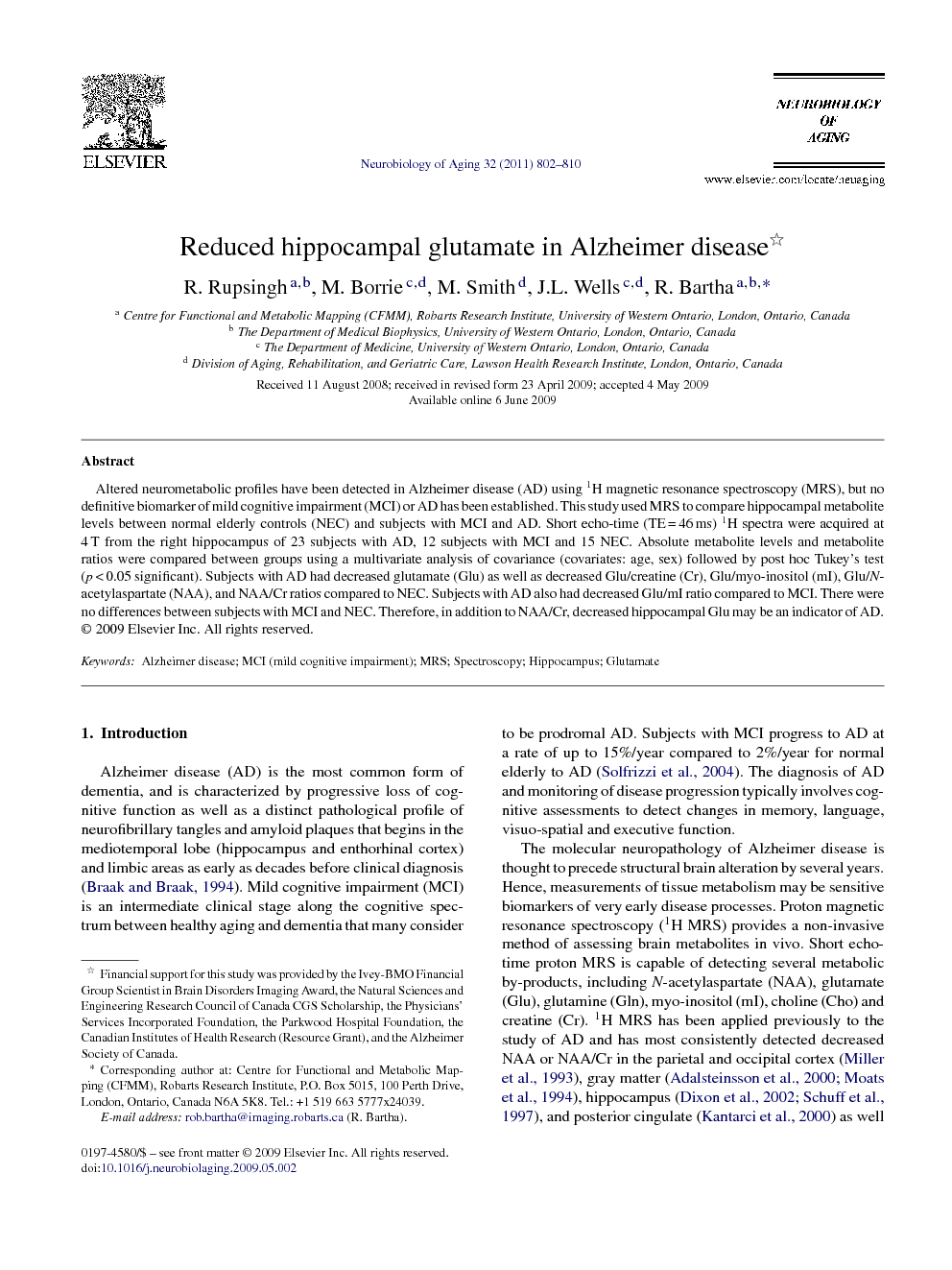Altered neurometabolic profiles have been detected in Alzheimer disease (AD) using 1H magnetic resonance spectroscopy (MRS), but no definitive biomarker of mild cognitive impairment (MCI) or AD has been established. This study used MRS to compare hippocampal metabolite levels between normal elderly controls (NEC) and subjects with MCI and AD. Short echo-time (TE = 46 ms) 1H spectra were acquired at 4 T from the right hippocampus of 23 subjects with AD, 12 subjects with MCI and 15 NEC. Absolute metabolite levels and metabolite ratios were compared between groups using a multivariate analysis of covariance (covariates: age, sex) followed by post hoc Tukey's test (p < 0.05 significant). Subjects with AD had decreased glutamate (Glu) as well as decreased Glu/creatine (Cr), Glu/myo-inositol (mI), Glu/N-acetylaspartate (NAA), and NAA/Cr ratios compared to NEC. Subjects with AD also had decreased Glu/mI ratio compared to MCI. There were no differences between subjects with MCI and NEC. Therefore, in addition to NAA/Cr, decreased hippocampal Glu may be an indicator of AD.
Alzheimer disease (AD) is the most common form of dementia, and is characterized by progressive loss of cognitive function as well as a distinct pathological profile of neurofibrillary tangles and amyloid plaques that begins in the mediotemporal lobe (hippocampus and enthorhinal cortex) and limbic areas as early as decades before clinical diagnosis (Braak and Braak, 1994). Mild cognitive impairment (MCI) is an intermediate clinical stage along the cognitive spectrum between healthy aging and dementia that many consider to be prodromal AD. Subjects with MCI progress to AD at a rate of up to 15%/year compared to 2%/year for normal elderly to AD (Solfrizzi et al., 2004). The diagnosis of AD and monitoring of disease progression typically involves cognitive assessments to detect changes in memory, language, visuo-spatial and executive function.
The molecular neuropathology of Alzheimer disease is thought to precede structural brain alteration by several years. Hence, measurements of tissue metabolism may be sensitive biomarkers of very early disease processes. Proton magnetic resonance spectroscopy (1H MRS) provides a non-invasive method of assessing brain metabolites in vivo. Short echo-time proton MRS is capable of detecting several metabolic by-products, including N-acetylaspartate (NAA), glutamate (Glu), glutamine (Gln), myo-inositol (mI), choline (Cho) and creatine (Cr). 1H MRS has been applied previously to the study of AD and has most consistently detected decreased NAA or NAA/Cr in the parietal and occipital cortex ( Miller et al., 1993), gray matter ( Adalsteinsson et al., 2000 and Moats et al., 1994), hippocampus ( Dixon et al., 2002 and Schuff et al., 1997), and posterior cingulate ( Kantarci et al., 2000) as well as increased mI in parietal and occipital cortex ( Miller et al., 1993), gray matter ( Moats et al., 1994), and posterior cingulate ( Kantarci et al., 2000).
Although Glu has been less well studied, it is the principal excitatory neurotransmitter involved in learning, memory and cognition and can be detected directly by short echo-time MRS. Previous MRS studies have reported decreased Glu levels in the cortex and hippocampus of transgenic AD mice (Marjanska et al., 2005) but only relative decreases in the sum of Glu and glutamine over creatine in subjects with AD in the cingulate cortex (Antuono et al., 2001 and Hattori et al., 2002) and posterior cingulate gyrus, precuneus, and portions of the cuneus (Hattori et al., 2002).
The purpose of this study was to compare hippocampal metabolite levels measured by high magnetic field MRS, particularly Glu, NAA and mI, in subjects with MCI, AD, and normal elderly controls (NEC). The secondary objective was to correlate these metabolite measures with cognitive test results.
This cross-sectional analysis of absolute metabolite levels and metabolite ratios in the hippocampus of subjects with AD has shown a distinct neurochemical profile that includes decreased Glu, NAA/Cr, Glu/Cr, Glu/mI, and Glu/NAA compared to normal elderly as well as decreased Glu/mI in AD compared to MCI. The MCI metabolite levels and metabolite ratios were generally intermediate to NEC and AD values, supporting the hypothesis of a pathological continuum.


